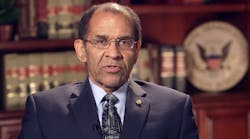Among transportation safety problems most in need of attention, "many of these relate to all modes of transportation," noted National Transportation Safety Board (NTSB) Chairman Christopher Hart Wednesday morning, Jan. 13 as he discussed the agency's 2016 "Most Wanted" list of improvements.
Certainly a majority of NTSB's top issues can be applied to trucking and highway transportation, with fatigue-related crashes making a prominent appearance and issues like distracted driving and medical fitness of safety-critical personnel — including truck drivers — carrying over from last year.
NTSB is an investigative rather than direct enforcement agency, but the list signals more scrutiny of and public attention to the issues at hand and can help steer other government agency action. "We can't require anyone to take action on our recommendations," Hart noted in a conference call, "so for 25 years, we've issued our 'Most Wanted' list hoping to start the conversation and spur action."
Watch video from an NTSB press conference on the 2016 top 10:
NTSB's 2016 list of safety improvements includes:
• Reduce fatigue-related accidents. This new list item is an area where NTSB focuses some attention directly at trucking — not surprising, with recent high-level crash investigations finding fatigue as a factor, like the one involving a Walmart truck and comedian Tracy Morgan's SUV.
NTSB calls for "a comprehensive approach focused on research, education, training, technologies, treatment of sleep disorders, hours-of-service regulations, and on- and off-duty scheduling policies and practices." Of the agency's more than 180 major transportation incident investigations from 2001-2012, NTSB says one out of five involved fatigue.
"We see a lot of fatigue and it's a problem in many ways, starting with the fact that you can't really measure it," Hart said on the call. "It's been a huge issue for us."
• Promote availability of collision avoidance technology in highway vehicles. With a new mandate taking effect in 2017 for electronic stability control systems on heavy trucks, NTSB is hoping fleets won't wait till then, highlighting that this technology is available now.
"Currently available collision avoidance technologies for passenger and commercial vehicles (such as trucks and buses) could prevent crashes or minimize their impact, and should be standard equipment on all new vehicles," NTSB states in a brochure for the "most wanted" list. "If it were in all cars, trucks and buses, it could save many lives on the highway," Hart contended regarding the technology.
In a release following the NTSB top issues announcement, the National Safety Council applauded NTSB's inclusion of collision avoidance technology — and also made the point that drivers may need education because they often are confused when tech takes over vehicle operation. "Most fatal car crashes involve multiple vehicles, amplifying the importance of collision avoidance technologies . . . however, recent research shows the majority of drivers do not know how these features work," the organization stated.
• Strengthen occupant protection. While NTSB didn't specifically direct this newly included list item at trucking, notably, the Federal Motor Carrier Safety Administration recently proposed a rule that would hold truck drivers and their companies responsible for commercial vehicle passengers buckling up.
"Strengthened occupant protection systems could have reduced injuries and saved lives" in a number of crashes NTSB has investigated, the agency says, adding that improving the situation will require "increased use of existing restraint systems and better design and implementation of occupant protection systems."
• Expand use of recorders to enhance transportation safety. With this new issue, NTSB calls attention to including info/data recording devices mainly on vehicles other than heavy trucks. Even so, the argument mirrors points that trucking companies and fleets have made in deciding to install devices like video recording systems in trucks and other on-highway vehicles.
"Transportation operators and investigators must have an accurate picture of an accident to prevent future accidents. No single tool has helped determine what went wrong more than recorders," NTSB states. "Yet, certain categories of aircraft, trains, ferries, and buses are still not equipped with these critical technologies."
On the conference call, NTSB Vice Chairman Bella Dinh-Zarr mentioned video cameras on commercial trucks and noted that transportation companies of all kinds are voluntarily opting to include recording device technology, but many don't if it isn't required. "We think the time is right to get this not-well-known issue some attention," she said.
• Disconnect from deadly distractions. A well-known carryover issue, NTSB says it has found distracted driving to be a factor "in accidents across all modes of transportation" for years.
This is a big one: "A cultural change is needed for drivers and operators to disconnect from deadly distractions," according to NTSB. Law enforcement agencies around the country have made the same determination. NTSB calls for every driver to minimize distraction on every trip, an act it terms "the first step in safely operating any vehicle."
• End substance impairment in transportation. Another carryover issue for NTSB is substance abuse and impaired driving, and the agency notes that since the turn of the millennium, an alcohol-impaired driver has been involved in about a third of highway fatalities.
But booze isn't the only thing that can impair a driver, NTSB points out. "Our new reality is this: impaired driving now involves drugs — including prescribed and over-the-counter medicines — that can affect your ability to drive or operate any vehicle," NTSB states, calling for better data on the issue.
• Require medical fitness for duty. It's the last of the carried-over issues from 2015 that apply to trucking, and questions of operators' medical fitness to drive are nothing new in the world of trucking and fleet. The issue crosses over somewhat into the related one of fatigue.
Hart made that connection on the conference call, discussing fatigue caused by sleep disorders. "These medical problems can go undiagnosed. We're seeing increased accidents in connection with obstructive sleep apnea," he pointed out.
In its materials, NTSB also calls out the disparate medical screening requirements across transportation modes."When safety-critical personnel such as public vehicle operators have untreated or undiagnosed medical conditions preventing them from doing their job safely, people can be seriously injured or die," NTSB states.
The agency recommends "comprehensive medical certification systems for safety-critical transportation personnel to ensure that these professionals are medically fit for duty before operating a vehicle."
Three additional issues NTSB included this year apply specifically to rail or air transportation. They are the carryover of (1) preventing loss of control in flight and general aviation as well as new calls for (2) improving rail transit safety oversight and (3) promoting the completion of rail safety initiatives, that latter lumping together two former rail safety items.
Notably also with rail safety initiatives is that NTSB calls for rail operators not to delay in implementing positive train control technology, which compares to collision avoidance tech in trucks.
For more information on NTSB's "Most Wanted" list, visit www.NTSB.gov/MostWanted.



